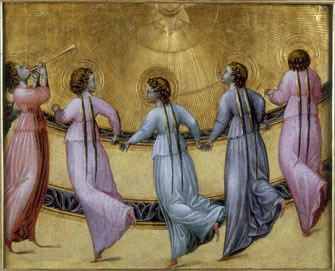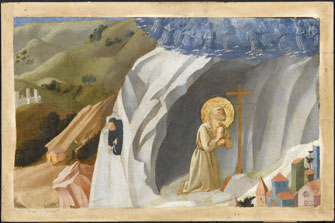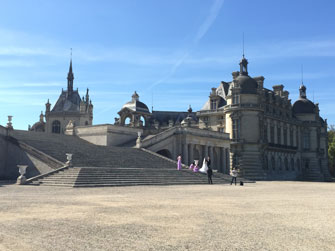Early Renaissance Altarpieces
Temporarily Reunited

“Cinq Anges Dansant au Pied d’un Trône” (c. 1430-35), by Giovanni di Paolo (13981482). © RMN-Grand Palais (Domaine de Chantilly)/Harry Bréjat
The Musée Condé in the Château de Chantilly has literally pieced together an exhibition from some of the masterworks in its fine collection, reuniting fragments of altarpieces with the companion panels they were long ago separated from and which now belong to far-flung museums and private collections.
There is much in this show that is fascinating and beautiful, but be forewarned that its title, “Fra Angelico, Botticelli: Rediscovered Masterpieces,” is rather misleading. These two Early Renaissance stars are represented in the show only by a couple of works. A more accurate title might have been “Florentine and Sienese Artists (and Their Studio Assistants) Associated with or Living Around the Same Time as Fra Angelico and Botticelli.”
Although the exhibition is rather disjointed and short on big-name masterpieces, it makes up for it by presenting a number of gorgeous paintings and high-quality, large-scale audiovisual aids that provide a full picture of many of the altarpieces and allow you to see details that are sometimes difficult to discern in the paintings themselves.
A high point of the exhibition is the reconstitution of Fra Angelico’s “Thebaid,” a depiction of events in the lives of the Church fathers. The panel belonging to the Musée Condé, “Saint Benoit en Extase au Désert,” has been reunited with other segments belonging

“Saint Benoit en Extase au Désert,” by Guido di Pietro, known as Fra Angelico and his workshop. © RMN-Grand Palais (Domaine de Chantilly)/René-Gabriel Ojéda
to museums in Philadelphia, Cherbourg and Antwerp, and one from a private collection. Take the time to study this piece, which may never come together this way again and is full of marvelous details. The scale of the painted figures in it varies in most amusing ways: some monks working in a garden, for example, are tiny, while other human figures are as big or bigger than the buildings near them. Colorful birds and butterflies take on outsized proportions. In one scene, a monk chats with the devil, and in another a bishop lectures a smaller monk sitting next to him, the bishop’s red hat lying in the dirt of the path at their feet.
The names of some of the other Quattrocento Florentine and Sienese painters may be less familiar to visitors to the exhibition, but that does not make them any less worth seeing. In fact, there were a number of felicitous discoveries, among them the late-Gothic Sienese painter Sasseta’s “The Mystic Marriage of St. Francis” (1437-44), depicting the saint and his companion with the three virtues, Faith, Hope and Charity. In the upper right-hand corner of the panel, the three graceful ladies fly off into the heavens. This marvelous piece belonging to the Musée Condé is one of 27 from the same polyptych painted for San Francesco Church in Borgo San Sepolcro. It is worth taking the time to watch the virtual reconstitution of this altarpiece.
The Musée Condé’s collection was given by Henri d’Orléans, Duc d’Aumale (1822-97), son of French king Louis-Philippe, to the Institut de France in 1886. Bored while in exile in England during the Second Empire, he had begun to build an art collection, which on his return to France he added to pieces that once belonged to the Princes de Condé, owners of the château from the 17th century to 1830. The condition for this gift and that of the château itself was that the collections should not be loaned out and that their presentation not be changed.
One curiosity in the exhibition is the “Nude Mona Lisa,” which, while it has the unmistakable stamp of Leonardo’s atelier, is awkward and cartoonish. When the Duc d’Aumale purchased it, he thought he was buying a preparatory study for the Mona Lisa made by Leonardo himself. While the work is believed to come from Leonardo’s studio, no one knows who drew it (most likely an apprentice) or if it was created prior to or after its famous sister in the Louvre.
The exhibition is being held in the estate’s Jeu de Paume, an outbuilding that once housed tennis courts, reached via a pleasant walk through the park from the château.
If you can, plan to spend the whole day at Chantilly, a 24-minute RER ride from Paris, to explore the museum’s permanent collection and its period rooms, including a handsome library with a collection of illuminated manuscripts. There is also a horse museum in the extensive stables next to the racetrack.
In the château’s large formal park, traversed by a canal, is a hamlet of thatched-roof cottages. When Marie-Antoinette paid a visit, she just

The Château de Chantilly with wedding party, seen from the park.
had to keep up with the Condés and have one of her own: thus was born the Queen’s Hamlet, her make-believe farm at Versailles. One of the buildings has been turned into a restaurant, Le Hameau, where you can have lunch, finishing with a dessert topped with crème Chantilly in the very place where it was invented: the Condé princes liked to surprise their guests with it during lavish 18th-century picnics in the hamlet. This delicious crème Chantilly can also be sampled in La Capitainerie, a more formal restaurant located in the kitchens of the château, once presided over by chef François Vatel, who famously killed himself during a three-day banquet being given for Louis XIV, in despair because the fish delivery had not arrived on time.
Domaine de Chantilly: Open until November 2 Wednesday-Monday, 10am-6pm; November 3-January 5 10am-5pm. Closed Tuesday. Take SNCF train from Gare du Nord to to Chantilly-Gouvieux or take RER line D to Chantilly-Gouvieux. Admission: €10. Through January 4, 2014. www.domainedechantilly.com
Click here to read all of this week’s new articles on the Paris Update home page.
Reader Reaction: Click here to respond to this article (your response may be published on this page and is subject to editing).
Support Paris Update by ordering books from Paris Update’s Amazon store at no extra cost. Click on your preferred Amazon location: U.K., France, U.S.
© 2014 Paris Update
Favorite